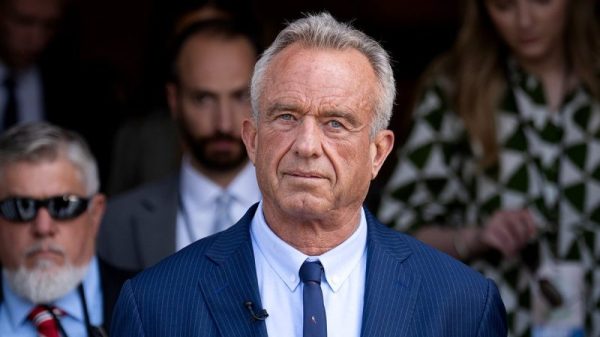Let’s stipulate at the outset that President Biden’s ongoing difficulties with younger voters — stark when measured overall, less so when considered through the lens of party — are probably not heavily driven by enthusiasm for Donald Trump.
To some degree, sure. But if we accept that Biden is having trouble figuring out what message resonates with voters under 30, we should probably also accept that clunky, dishonest, obviously pandering appeals from Trump (like Monday’s “Crooked Joe Biden is responsible for banning TikTok” riff) aren’t a major driver.
Often, analyses of Biden’s relatively poor performance among young voters center on his support for Israel’s response to the Oct. 7 terrorist attacks by Hamas. Younger voters are demonstrably more sympathetic to the Palestinians in Gaza than are older Americans, and many see Biden’s loyalty to Israel as a moral failure. Democratic concerns about how Arab Americans would view Biden in November have expanded to younger Americans more broadly.
These analyses, though, overlook an important point: Biden has had trouble with younger voters for years.
In April 2022 I looked at the decline in Biden’s approval rating since his inauguration, noting that it was sharpest among the youngest Americans. At the time, I chalked it up in part to the overlap of young voters and nonpartisans, among whom Biden’s approval had also fallen sharply. In part, it was also because he had further to fall with those voters.
In YouGov polling since Biden took office, you can see a lot of volatility in how younger voters view the sitting president. The lines below show the average of YouGov approval polls over the preceding 30 days (with individual polls shown as dots). You can see that faster-than-voters-overall plunge throughout 2021 — and then a resurgence among younger Americans into 2023. Then, in spring 2023, a big drop followed by a slow climb and then, recently, another drop.
(The Oct. 7 attack is shown with a vertical dashed line for reference.)
The resurgence was also seen among independents, but otherwise, the under-30 polling has been much more volatile. This isn’t surprising by itself. The subgroup of respondents under 30 is relatively small compared with other groups and that lends itself to more volatility and bigger swings in opinion.
If we compare polling among those under 30, independents and those 65 and older to the overall approval rating Biden has seen, we see that the period coming into 2022 was the only time in which his approval among younger Americans was lower than his overall approval. The recent drop threatens to have the same effect, but he’s not there yet.
The point here isn’t that we know why those numbers are going up and down. It’s that they are consistently volatile and not newly low relative to Biden’s overall approval numbers.
Gallup polling offers a different perspective on younger Americans. In February, we reported on Gallup data showing that younger Americans had shifted to the right since 2020. That’s probably in part because Gallup is looking at all adults, not just registered voters (which is the group included in YouGov’s data). But notice how Gallup’s assessments of Biden’s approval differs since 2021: Younger Americans are consistently less approving of Biden than Americans overall.
Or, shown in the same manner as the YouGov data, you can see that the orange line is fairly consistently under the midpoint here, meaning that in most months Biden has lower approval from young Americans than from Americans overall. The opposite is true among older Americans.
The Gallup data are monthly, and only through the end of March. There may be a further decline in the April numbers mirroring the recent YouGov drop. But the point remains: lower-than-overall approval isn’t itself new.
The difference between the YouGov and Gallup data and who is included in their measures is important for thinking about November, as we wrote on Monday morning. But the point here is different: it’s to note that Biden’s approval among younger Americans — and even the recent drop seen in YouGov’s data — are not a new development.
To the extent that he has one, then, Biden’s problem with younger voters isn’t solely one that derives from his handling of Gaza.
Let’s stipulate at the outset that President Biden’s ongoing difficulties with younger voters — stark when measured overall, less so when considered through the lens of party — are probably not heavily driven by enthusiasm for Donald Trump.
To some degree, sure. But if we accept that Biden is having trouble figuring out what message resonates with voters under 30, we should probably also accept that clunky, dishonest, obviously pandering appeals from Trump (like Monday’s “Crooked Joe Biden is responsible for banning TikTok” riff) aren’t a major driver.
Often, analyses of Biden’s relatively poor performance among young voters center on his support for Israel’s response to the Oct. 7 terrorist attacks by Hamas. Younger voters are demonstrably more sympathetic to the Palestinians in Gaza than are older Americans, and many see Biden’s loyalty to Israel as a moral failure. Democratic concerns about how Arab Americans would view Biden in November have expanded to younger Americans more broadly.
These analyses, though, overlook an important point: Biden has had trouble with younger voters for years.
In April 2022 I looked at the decline in Biden’s approval rating since his inauguration, noting that it was sharpest among the youngest Americans. At the time, I chalked it up in part to the overlap of young voters and nonpartisans, among whom Biden’s approval had also fallen sharply. In part, it was also because he had further to fall with those voters.
In YouGov polling since Biden took office, you can see a lot of volatility in how younger voters view the sitting president. The lines below show the average of YouGov approval polls over the preceding 30 days (with individual polls shown as dots). You can see that faster-than-voters-overall plunge throughout 2021 — and then a resurgence among younger Americans into 2023. Then, in spring 2023, a big drop followed by a slow climb and then, recently, another drop.
(The Oct. 7 attack is shown with a vertical dashed line for reference.)
The resurgence was also seen among independents, but otherwise, the under-30 polling has been much more volatile. This isn’t surprising by itself. The subgroup of respondents under 30 is relatively small compared with other groups and that lends itself to more volatility and bigger swings in opinion.
If we compare polling among those under 30, independents and those 65 and older to the overall approval rating Biden has seen, we see that the period coming into 2022 was the only time in which his approval among younger Americans was lower than his overall approval. The recent drop threatens to have the same effect, but he’s not there yet.
The point here isn’t that we know why those numbers are going up and down. It’s that they are consistently volatile and not newly low relative to Biden’s overall approval numbers.
Gallup polling offers a different perspective on younger Americans. In February, we reported on Gallup data showing that younger Americans had shifted to the right since 2020. That’s probably in part because Gallup is looking at all adults, not just registered voters (which is the group included in YouGov’s data). But notice how Gallup’s assessments of Biden’s approval differs since 2021: Younger Americans are consistently less approving of Biden than Americans overall.
Or, shown in the same manner as the YouGov data, you can see that the orange line is fairly consistently under the midpoint here, meaning that in most months Biden has lower approval from young Americans than from Americans overall. The opposite is true among older Americans.
The Gallup data are monthly, and only through the end of March. There may be a further decline in the April numbers mirroring the recent YouGov drop. But the point remains: lower-than-overall approval isn’t itself new.
The difference between the YouGov and Gallup data and who is included in their measures is important for thinking about November, as we wrote on Monday morning. But the point here is different: it’s to note that Biden’s approval among younger Americans — and even the recent drop seen in YouGov’s data — are not a new development.
To the extent that he has one, then, Biden’s problem with younger voters isn’t solely one that derives from his handling of Gaza.





















